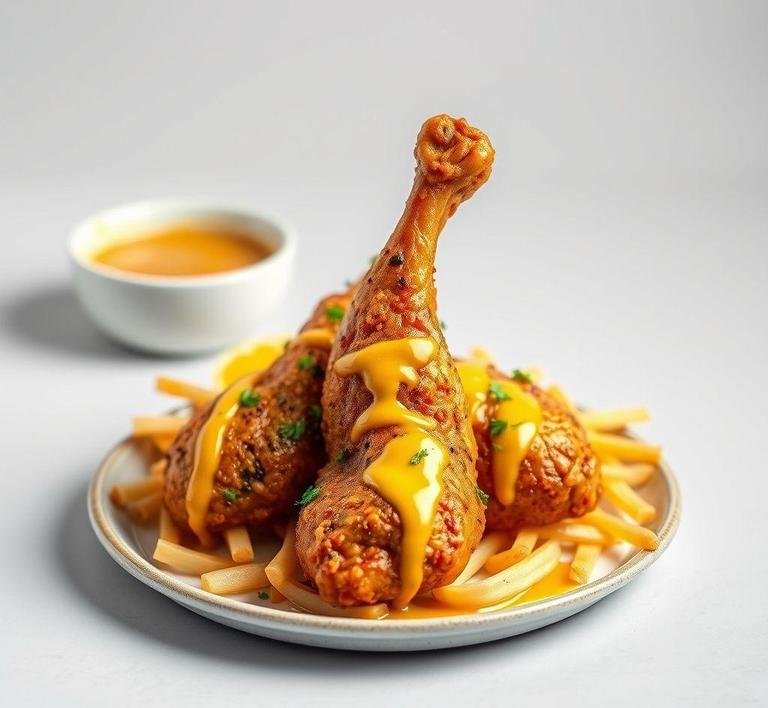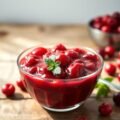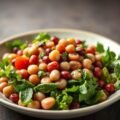Mary Berry’s Double Mustard Chicken is a hearty, creamy chicken dish infused with the warm punch of two types of mustard: wholegrain and Dijon. It’s one of those elegant yet unfussy recipes that epitomizes Mary Berry’s signature style-bringing sophistication to the dinner table without intimidating you in the kitchen.
This dish pairs tender, golden-browned chicken thighs with a luscious sauce that’s rich with cream, subtly sweet shallots, white wine, and the distinctive tang of mustard. The "double mustard" element adds both complexity and depth-Dijon provides a sharp, smooth heat while wholegrain brings a milder bite and rustic texture.
It’s a dish perfect for everything from Sunday dinners to dinner parties. And the best part? It’s surprisingly simple to make. Let’s break it all down.
Mary Berry’s Double Mustard Chicken Recipe
Ingredients Needed

Here’s your shopping list of everything you’ll need. These ingredients serve about 4 people.
For The Chicken
- 8 skinless, boneless chicken thighs – juicy and perfect for slow simmering
- 2 tbsp olive oil – for browning the chicken
- Salt and freshly ground black pepper – seasoning is key here
For The Sauce
- 2 shallots, finely chopped – adds a gentle sweetness
- 150ml dry white wine – elevates the dish with acidity and depth
- 150ml chicken stock – the savory base
- 150ml double cream (heavy cream) – for that silky finish
- 1 tbsp Dijon mustard – sharp and tangy
- 1 tbsp wholegrain mustard – mellow with a little crunch
- A small handful of chopped fresh parsley – for garnish and a fresh pop of green
Optional: A squeeze of lemon juice at the end can brighten the sauce even more.
Equipment Needed
Nothing fancy here-just some kitchen essentials:
- Large frying pan or sauté pan (preferably with a lid)
- Sharp knife
- Cutting board
- Measuring jug
- Wooden spoon or spatula
- Small bowl (for mixing the mustard and cream, if you prefer to combine before adding)
Optional: A spoon rest or plate nearby for easy transfer of utensils while cooking.
Instructions To Make Mary Berry’s Double Mustard Chicken
Here’s how to bring this dish to life, step by step:
1. Prepare The Chicken
Start by seasoning your chicken thighs generously with salt and pepper on both sides. This is the foundation of flavor, so don’t skip this step!
2. Brown The Chicken
Heat the olive oil in a large pan over medium-high heat. Once it’s shimmering, add the chicken thighs. You want to brown them on both sides – roughly 4-5 minutes per side. You’re not cooking them through just yet, but this golden crust will bring tons of flavor to the final dish.
Once browned, remove the chicken from the pan and set it aside.
3. Soften The Shallots
In the same pan (don’t clean it-you want all that good flavor!), reduce the heat to medium. Add the chopped shallots and sauté gently for about 2-3 minutes until they become translucent and soft. Stir often to prevent burning.
4. Deglaze With Wine
Pour in the white wine to deglaze the pan, scraping up any brown bits from the bottom with your spoon. Let it bubble and reduce for about 2-3 minutes-this intensifies the flavor and burns off the alcohol.
5. Add The Cream And Mustards
Now comes the magic: Stir in the chicken stock, double cream, Dijon mustard, and wholegrain mustard. Mix well until the sauce is smooth and cohesive. Let it simmer gently for 2-3 minutes.
6. Return The Chicken To The Pan
Nestle the browned chicken thighs back into the pan, spooning some sauce over the top. Cover with a lid and let it simmer on low heat for 15-20 minutes, or until the chicken is cooked through and tender. If the sauce gets too thick, you can add a splash more stock or cream.
7. Garnish And Serve
Once cooked, taste the sauce and adjust seasoning if needed. A little squeeze of lemon juice at this point can lift the whole dish. Sprinkle with chopped parsley for color and freshness.
Serve with buttery mashed potatoes, steamed green beans, or crusty bread to mop up that amazing sauce.
Tips And Tricks
- Use chicken thighs over breasts: They stay juicier and have a richer flavor that stands up well to the bold sauce.
- Deglaze like a pro: Don’t skip the deglazing step-it captures all those golden caramelized bits left from browning the chicken, adding layers of flavor to your sauce.
- Don’t boil the sauce: Once you add cream, keep it at a gentle simmer. Boiling can cause the cream to split.
- Wine alternatives: No wine on hand? You can substitute with extra chicken stock and a splash of white wine vinegar for that acidic bite.
- Make it ahead: This dish actually tastes even better the next day, making it a great make-ahead meal. Just reheat gently on the stove to avoid overcooking the chicken.
- Serving ideas: It’s versatile! Serve with rice, mashed potatoes, or even pasta. The sauce works beautifully as a coating over almost any starch.
Mary Berry’s Double Mustard Chicken is the kind of recipe that becomes a regular in your rotation after just one try. It’s rich but not heavy, sharp yet balanced, and luxurious without being high-maintenance. The dual mustards create a layered flavor profile that’s both comforting and just adventurous enough to impress guests or satisfy your own craving for something deeply delicious.
Whether you’re a longtime Mary Berry fan or new to her classic British cooking, this dish captures her timeless approach: cook with care, use simple quality ingredients, and never underestimate the power of a good sauce. Try it once, and you’ll be hooked.
Easy Recipe Variations For Mary Berry’s Double Mustard Chicken

Mary Berry’s Double Mustard Chicken is already a masterclass in flavor layering. With the piquant sharpness of wholegrain mustard and the mellow heat of Dijon, paired with tender chicken and a creamy sauce, it’s a guaranteed crowd-pleaser. But like any great recipe, it’s incredibly versatile. Let’s explore some easy, delectable variations to keep your mealtimes fresh and exciting.
1. Swap the Protein:
While chicken breasts or thighs are traditional, don’t be afraid to branch out. Pork tenderloin makes an excellent alternative-especially when sliced into medallions and seared before simmering in the mustard sauce. Boneless turkey, especially the darker thigh meat, also pairs beautifully with the mustardy cream.
2. Make It Vegetarian-Friendly:
Transform the dish into a vegetarian delight by replacing the chicken with large chunks of roasted cauliflower, pan-fried halloumi, or thick slices of portobello mushrooms. These ingredients soak up the sauce splendidly while offering satisfying textures.
3. Add an Herbaceous Twist:
While thyme and parsley are often used, consider experimenting with tarragon, which adds a slightly licorice-like, French bistro-style flair. Chives or fresh basil stirred in at the end can add brightness and complexity.
4. Spice It Up:
Want to add some kick? A teaspoon of crushed chili flakes or a few dashes of Tabasco can elevate the dish’s heat. A spoonful of horseradish mixed into the sauce also plays beautifully with the mustard flavors and adds a zingy punch.
5. Enrich the Sauce:
For an even more luxurious mouthfeel, swap some or all of the crème fraîche or double cream with mascarpone or soft cream cheese. You can also deglaze your pan with a splash of white wine or chicken stock before adding the cream and mustards-this not only lifts all those caramelized bits but adds a depth of flavor that’s hard to resist.
6. Add Vegetables for a One-Pan Meal:
For a complete meal in one skillet, toss in vegetables like green beans, baby spinach, or even halved cherry tomatoes toward the end of cooking. You’ll get pops of color, nutrition, and taste in every bite.
Storing Leftovers
If you happen to have leftovers (which is a rare phenomenon with this dish!), proper storage is key to preserving both the texture and the tangy flavor of the mustard sauce.
Refrigeration Tips:
Let the chicken cool completely before transferring it to an airtight container. Store it in the fridge for up to 3 days. Be sure to scoop up all the sauce-it’s gold!
Reheating Recommendations:
When reheating, go low and slow. A gentle simmer in a pan over medium-low heat works best, adding a splash of milk or cream to revive the sauce without curdling. Avoid microwaving if you can-it tends to make the chicken rubbery and the sauce separate.
Freezing Advice:
While it’s technically possible to freeze the dish, creamy sauces can sometimes split when thawed. If you plan to freeze it, allow the dish to cool, then portion it into freezer-safe containers. When reheating from frozen, thaw overnight in the fridge and reheat gently, stirring frequently to bring the sauce back together.
What To Eat With Mary Berry’s Double Mustard Chicken?
Pairing is everything, and with a rich and tangy dish like Mary Berry’s Double Mustard Chicken, the right side dishes can turn a good meal into a memorable one. Whether you’re serving a cozy family dinner or impressing guests, here are some brilliant accompaniments to consider:
1. Potatoes in All Forms:
Creamy mashed potatoes are a classic-smooth, buttery, and perfect for soaking up that luscious sauce. Roasted baby potatoes with a crispy exterior and fluffy interior also work beautifully. If you want to be slightly fancy, try pommes Anna or even a creamy gratin dauphinois.
2. Rice or Grains:
Fluffy white basmati rice, nutty brown rice, or even a wild rice mix provides a nice textural contrast. Quinoa or pearl barley offer a wholesome, slightly chewy base that absorbs the sauce and adds a subtle nuttiness.
3. Crusty Bread or Garlic Toast:
A rustic French baguette or a slice of toasted sourdough is ideal for mopping up every drop of mustard sauce. Want to elevate it further? Make garlic-rubbed toast or a buttery herb focaccia.
4. Light Salads:
Balance out the richness with a crisp green salad-think peppery rocket, shaved fennel, radishes, and a lemon vinaigrette. A cucumber-dill salad or a tangy coleslaw also pairs wonderfully by cutting through the creaminess.
5. Roasted or Steamed Veggies:
Green beans, tenderstem broccoli, or asparagus spears make for a bright and nutritious pairing. Toss them with olive oil and sea salt, or give them a quick steam for a clean, crisp bite.
6. Wine Pairing (for those inclined):
A chilled glass of Chardonnay or a lightly oaked white Burgundy complements the creamy sauce nicely. If you’re going red, go for something light and fruity like Pinot Noir.
Conclusion
Mary Berry’s Double Mustard Chicken is far more than a weeknight dinner-it’s a canvas for creativity, comfort, and culinary joy. With its bold mustardy kick, creamy richness, and endlessly adaptable nature, it lends itself to a variety of ingredients, flavors, and occasions. Whether you’re sticking close to the original or venturing into new territory with exciting variations, this dish is bound to become a beloved staple in your kitchen.
Don’t forget to store your leftovers wisely, get inventive with your side dishes, and enjoy the process of making this classic British favorite your own. Because at the heart of Mary Berry’s timeless cooking is not just technique-but warmth, elegance, and a dash of adventure.
FAQs
What Makes Mary Berry’s Double Mustard Chicken Different From Other Chicken Recipes?
Mary Berry’s double mustard chicken stands out due to its unique combination of two types of mustard-wholegrain and Dijon. The mustard not only adds depth of flavor but also helps create a rich, tangy glaze that caramelizes beautifully while cooking. This recipe also includes the addition of cream, which makes the sauce silky smooth and complements the sharpness of the mustard.
Can I Use Different Types Of Mustard In Mary Berry’s Double Mustard Chicken Recipe?
Yes, you can experiment with different types of mustard to suit your taste. While the recipe calls for both Dijon and wholegrain mustard, you can adjust the ratio or swap them for other varieties like English mustard for more heat, or even a honey mustard for a sweeter twist. However, keep in mind that changing the types of mustard may slightly alter the flavor profile of the dish.
How Can I Make Mary Berry’s Double Mustard Chicken Recipe Healthier?
To make this recipe healthier, you can substitute the heavy cream with a lighter version, such as double cream or even a plant-based cream alternative if you’re looking for a dairy-free option. Additionally, using skinless chicken breasts instead of thighs will reduce the fat content while still maintaining the deliciously rich flavor. For a lighter sauce, you can also reduce the amount of mustard and cream and incorporate more chicken stock.


